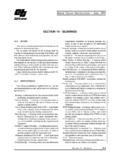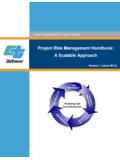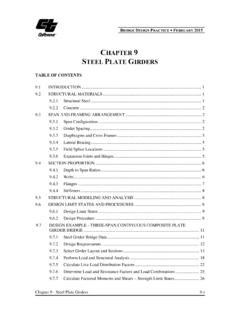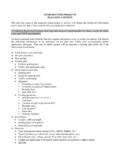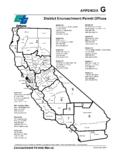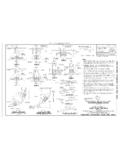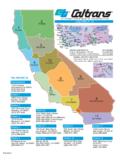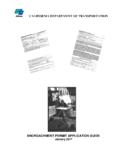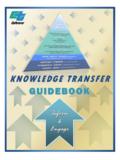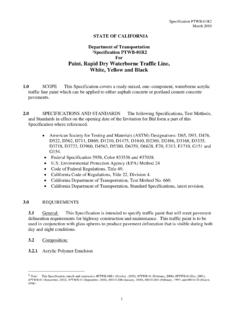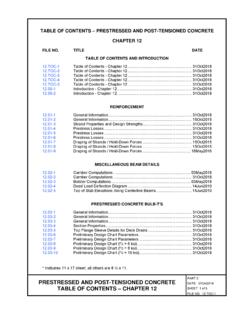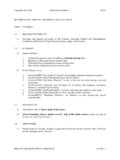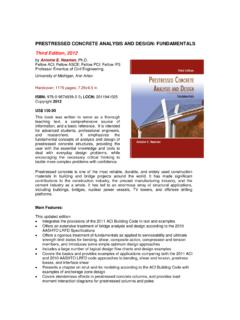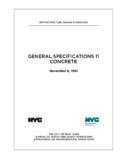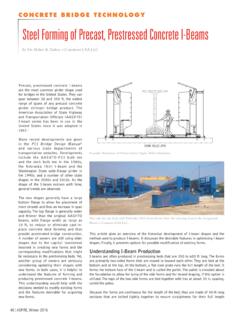Transcription of SECTION 9 - PRESTRESSED CONCRETE - Caltrans
1 BRIDGE DESIGN SPECIFICATIONS APRIL 2000 SECTION 9 - PRESTRESSED CONCRETE Part A General Requirements and Materials APPLICATION General The specifications of this SECTION are intended for design of PRESTRESSED CONCRETE bridge members. Mem bers designed as reinforced CONCRETE , except for a per centage of tensile steel stressed to improve service behav ior, shall conform to the applicable specifications of SECTION 8. Exceptionally long span or unusual structures require detailed consideration of effects which under this SECTION may have been assigned arbitrary values. Notations As = area of non- PRESTRESSED tension reinforcement (Articles and ) A's = area of compression reinforcement (Article ) A*s = area of prestressing steel (Article ) Asf = steel area required to develop the compressive strength of the overhanging portions of the flange (Article ) Asr = steel area required to develop the compressive strength of the web of a flanged SECTION (Articles ) Av = area of web reinforcement (Article ) b = width of flange of flanged member or width of rectangular member bv = width of cross SECTION at the contact surface being investigated for horizontal shear (Article ) b' = width of a web of a flanged member CRc = loss of prestress due to creep of CONCRETE (Article ) CRs = loss of prestress due to relaxation of prestressing steel (Article ) D = nominal diameter of prestressing steel (Articles and )
2 + d = distance from extreme compressive fiber to cen troid of the prestressing force, or to centroid of negative moment reinforcing for precast girder bridges made continuous dt = distance from the extreme compressive fiber to the centroid of the non- PRESTRESSED tension rein forcement (Articles and ) ES = loss of prestress due to elastic shortening (Article ) e = base of Naperian logarithms (Article ) fcds = average CONCRETE compressive stress at the of the prestressing steel under full dead load (Article ) fcir = average CONCRETE stress at the of the prestress ing steel at time of release (Article ) f'c = compressive strength of CONCRETE at 28 days f'ci = compressive strength of CONCRETE at time of initial prestress (Article ) fct = average splitting tensile strength of lightweight aggregate CONCRETE , psi fd = stress due to unfactored dead load, at extreme fiber of SECTION where tensile stress is caused by externally applied loads (Article ) fpc = compressive stress in CONCRETE (after allowance for all prestress losses) at centroid of cross SECTION resisting externally applied loads or at junction of web and flange when the centroid lies within the flange (In a composite member, fpc is resultant compressive stress at centroid of composite sec tion, or at junction of web and flange when the centroid lies within the flange, due to both pre stress and moments resisted by precast member acting alone.)
3 (Article ) fpe = compressive stress in CONCRETE due to effective prestress forces only (after allowance for all pre stress losses) at extreme fiber of SECTION where tensile stress is caused by externally applied loads (Article ) SECTION 9 PRESTRESSED CONCRETE 9-1 BRIDGE DESIGN SPECIFICATIONS APRIL 2000 fps = guaranteed ultimate tensile strength of the pre stressing steel, A*sf's fr = the modulus of rupture of CONCRETE , as defined in Article (Article ) fs = total prestress loss, excluding friction (Article ) fse = effective steel prestress after losses f*su = average stress in prestressing steel at ultimate load f's = ultimate stress of prestressing steel (Articles and ) fsy = yield stress of non- PRESTRESSED conventional rein forcement in tension (Article and ) f'y = yield stress of non- PRESTRESSED conventional rein forcement in compression (Article ) f*y = yield stress of prestressing steel (Article ) = f's for low-relaxation wire or strand = f's for stress-relieved wire or strand = f's for Type I (smooth) high-strength bar = f's for Type II (deformed) high-strength bar h = overall depth of member (Article ) I = moment of inertia about the centroid of the cross SECTION (Article ) K = friction wobble coefficient per foot of prestress ing steel (Article ) L = length of prestressing steel element from jack end to point x (Article ) Mcr = moment causing flexural cracking at SECTION due to externally applied loads (Article ) M*cr = cracking moment (Article ) Md/c = composite dead load moment at the SECTION (Com mentary to Article ) Md/nc= non-composite dead load moment at the SECTION (Article ) Mmax = maximum factored moment at SECTION due to externally applied loads (Article ) Mn = nominal moment strength of a SECTION Mu = factored moment at SECTION Mn (Articles and )
4 P = As/bdt, ratio of non- PRESTRESSED tension reinforce ment (Articles and ) p*= A*s/bd, ratio of prestressing steel (Articles and ) p' = A's/bd, ratio of compression reinforcement (Ar ticle ) Pu = factored tendon force Q = statical moment of cross-sectional area, above or below the level being investigated for shear, about the centroid (Article ) SH = loss of prestress due to CONCRETE shrinkage (Ar ticle ) s = longitudinal spacing of the web reinforcement (Article ) Sb = non-composite SECTION modulus for the extreme fiber of SECTION where the tensile stress is caused by externally applied loads (Article ) Sc = composite SECTION modulus for the extreme fiber of SECTION where the tensile stress is caused by externally applied loads (Article ) t = average thickness of the flange of a flanged mem ber (Articles and ) To = steel stress at jacking end (Article ) Tx = steel stress at any point x (Article ) v = permissible horizontal shear stress (Article ) Vc = nominal shear strength provided by CONCRETE (Ar ticle ) Vci = nominal shear strength provided by CONCRETE when diagonal cracking results from combined shear and moment (Article ) Vcw = nominal shear strength provided by CONCRETE when diagonal cracking results from excessive princi pal tensile stress in web (Article ) Vd = shear force at SECTION due to unfactored dead load (Article ) Vi = factored shear force at SECTION due to externally applied loads occurring simultaneously with Mmax (Article ) Vnh = nominal horizontal shear strength (Article ) Vp = vertical component of effective prestress force at SECTION (Article ) Vs = nominal shear strength provided by shear rein forcement (Article ) Vu = factored shear force at SECTION (Article ) Yt = distance from centroidal axis of gross SECTION , neglecting reinforcement, to extreme fiber in ten sion (Article )
5 = friction curvature coefficient (Article ) SECTION 9 PRESTRESSED CONCRETE 9-2 BRIDGE DESIGN SPECIFICATIONS APRIL 2000 = total angular change of prestressing steel profile in radians from jacking end to point x (Article ) = factor for CONCRETE strength, as defined in Article (Articles ) * = factor for type of prestressing steel (Article ) = for low-relaxation steel = for stress-relieved steel = for bars Definitions The following terms are defined for general use. Specialized definitions appear in individual articles. Anchorage device The hardware assembly used for transferring a post-tensioning force from the tendon wires, strands or bars to the CONCRETE . Anchorage Seating Deformation of anchorage or seat ing of tendons in anchorage device when prestressing force is transferred from jack to anchorage device. Anchorage Spacing Center-to-center spacing of an 1chorage devices. Anchorage Zone The portion of the structure in which the concentrated prestressing force is transferred from the anchorage device into the CONCRETE (Local Zone), and then distributed more widely into the structure (General Zone) (Article ).
6 Basic Anchorage Device Anchorage device meeting the restricted bearing stress and minimum plate stiffness requirements of Articles through ; no acceptance test is required for Basic Anchorage De vices. Bonded Tendon Prestressing tendon that is bonded to CONCRETE either directly or through grouting. Coating Material used to protect prestressing ten dons against corrosion, to reduce friction between tendon and duct, or to debond prestressing tendons. Couplers (Couplings) Means by which prestressing force is transmitted from one partial-length prestressing tendon to another. Creep of CONCRETE Time-dependent deformation of CONCRETE under sustained load. Curvature Friction Friction resulting from bends or curves in the specified prestressing tendon profile. Debonding (blanketing) Wrapping, sheathing, or coating prestressing strand to prevent bond between strand and surrounding CONCRETE . Diaphragm Transverse stiffener in girders to main tain SECTION geometry.
7 Duct Hole or void formed in PRESTRESSED member to accommodate tendon for post-tensioning. Edge Distance Distance from the center of the an chorage device to the edge of the CONCRETE member. Effective Prestress Stress remaining in CONCRETE due to prestressing after all calculated losses have been de ducted, excluding effects of superimposed loads and weight of member; stress remaining in prestressing ten dons after all losses have occurred excluding effects of dead load and superimposed load. Elastic Shortening of CONCRETE Shortening of mem ber caused by application of forces induced by prestress ing. End Anchorage Length of reinforcement, or me chanical anchor, or hook, or combination thereof, be yond point of zero stress in reinforcement. End Block Enlarged end SECTION of member designed to reduce anchorage stresses. Friction (post-tensioning) Surface resistance between tendon and duct in contact during stressing. General Zone Region within which the concentrated prestressing force spreads out to a more linear stress distribution over the cross SECTION of the member (Saint Venant Region) (Article ).
8 Grout Opening or Vent Inlet, outlet, vent, or drain in post-tensioning duct for grout, water, or air. Intermediate Anchorage Anchorage not located at the end surface of a member or segment; usually in the form of embedded anchors, blisters, ribs, or recess pock ets. Jacking Force Temporary force exerted by device that introduces tension into prestressing tendons. Local Zone The volume of CONCRETE surrounding and immediately ahead of the anchorage device, subjected to high local bearing stresses (Article ). Loss of Prestress Reduction in prestressing force resulting from combined effects of strains in CONCRETE and steel, including effects of elastic shortening, creep and shrinkage of CONCRETE , relaxation of steel stress, and for post-tensioned members, friction and anchorage seating. Post-Tensioning Method of prestressing in which tendons are tensioned after CONCRETE has hardened. Precompressed Zone Portion of flexural member cross- SECTION compressed by prestressing force.
9 PRESTRESSED CONCRETE Reinforced CONCRETE in which internal stresses have been introduced to reduce potential tensile stresses in CONCRETE resulting from loads. Pretensioning Method of prestressing in which ten dons are tensioned before CONCRETE is placed. SECTION 9 PRESTRESSED CONCRETE 9-3 BRIDGE DESIGN SPECIFICATIONS APRIL 2000 Relaxation of Tendon Stress Time-dependent reduc tion of stress in prestressing tendon at constant strain. Shear Lag Non-uniform distribution of bending stress over the cross SECTION . Shrinkage of CONCRETE Time-dependent deformation of CONCRETE caused by drying and chemical changes (hydration process). Special Anchorage Device Anchorage device whose adequacy must be proven experimentally in the standard ized acceptance tests of Division II, SECTION Tendon Wire, strand, or bar, or bundle of such ele ments, used to impart prestress to CONCRETE . Transfer Act of transferring stress in prestressing tendons from jacks or pretensioning bed to CONCRETE member.
10 Transfer Length Length over which prestressing force is transferred to CONCRETE by bond in pretensioned mem bers. Wobble Friction Friction caused by unintended de viation of prestressing sheath or duct from its specified profile or alignment. Wrapping or Sheathing Enclosure around a prestress ing tendon to avoid temporary or permanent bond be tween prestressing tendon and surrrounding CONCRETE . CONCRETE The specified compressive strength, f'c, of the con crete for each part of the structure shall be shown on the plans. REINFORCEMENT Prestressing Steel Wire, strands, or bars shall conform to one of the following specifications. Uncoated Stress-Relieved Wire for PRESTRESSED Con crete , AASHTO M 204. Uncoated Seven-Wire Stress-Relieved Strand for Pre stressed CONCRETE , AASHTO M 203. Uncoated High-Strength Steel Bar for Prestressing CONCRETE , ASTM A 722. Wire, strands, and bars not specifically listed in AASHTO M 204, AASHTO M 203, or ASTM A 722 may be used provided they conform to the minimum require ments of these specifications.
